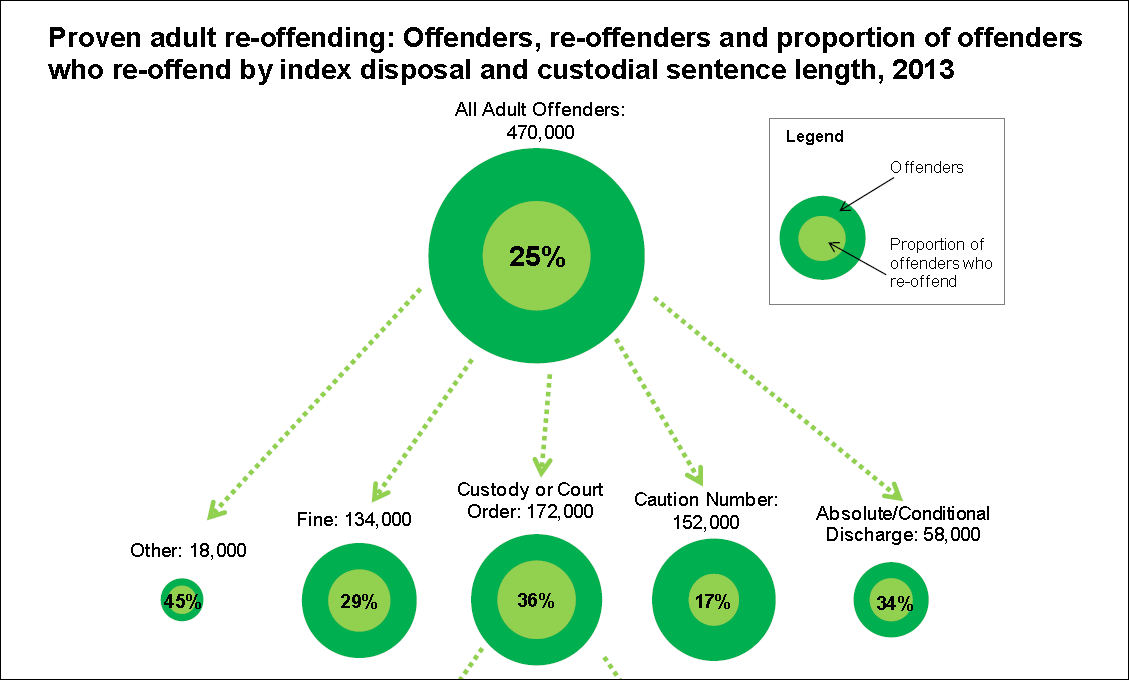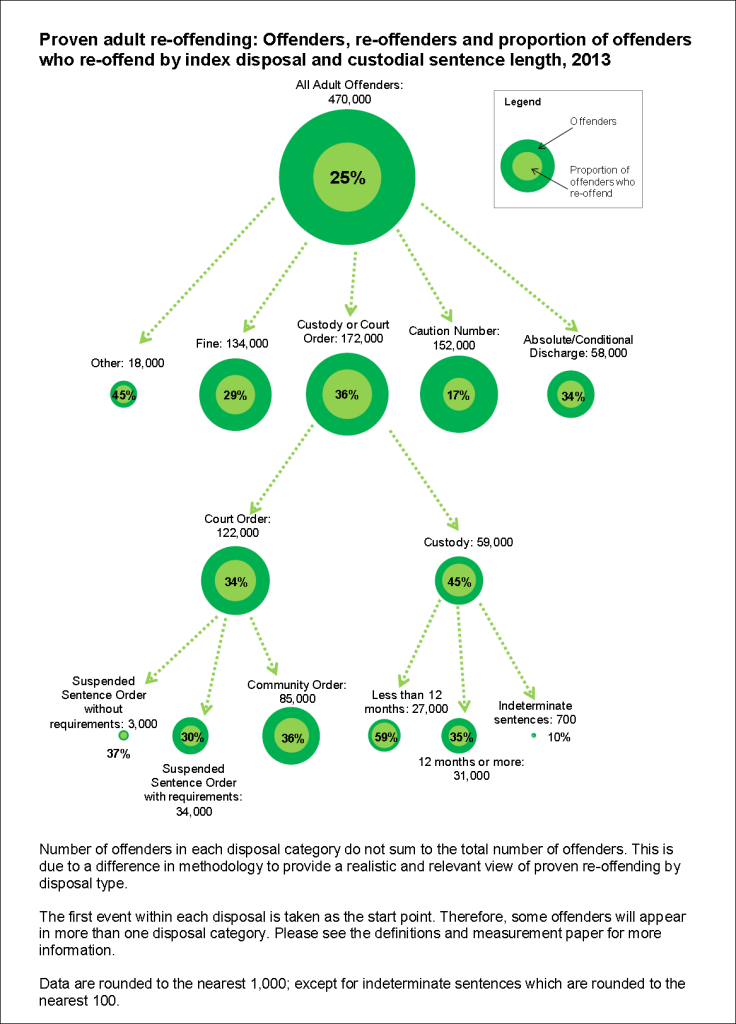Proven reoffending
Every quarter, the MoJ publishes a bulletin of proven reoffending rates for adult and juvenile offenders. The latest bulletin (29 October 2015) covers offenders who were released from custody or given a community sentence (or any other kind of sentence, caution, reprimand or warning) in the one year period from January – December 2013.
The statistics always lag 21 months behind, because reoffending is measured in the year following release or the making of a court order and a further six months are allowed for the court system to process these new offences with a further three months to analyse the statistics and produce the report.
Therefore this bulletin doesn’t measure performance of the new probation system since the split into National Probation Service and 21 new Community Rehabilitation Companies did not take place until June 2014 with new private providers starting operation on 1 February 2015.
The bulletin does of course cover the period when these Transforming Rehabilitation reforms were being implemented and the probation service was in turmoil with staff unsure who they would be working for or even if they would still have a job.
[divider]
Reoffending is up
Re-offending rates do tend to fluctuate with the overall rate between 26% and 29% over the last ten years. However, although the MoJ is keen to draw attention to the fact that figures are generally better than in 2003, almost all the figures are up on the previous year. The main overall findings are:
- In 2013 around 514,000 adult and juvenile offenders were cautioned, received a non-custodial conviction at court or released from custody. Around 136,000 of these offenders committed a proven re-offence within a year.
- This gives an overall proven re-offending rate of 26.5%; up 0.5 percentage points compared to the previous 12 months.
- Around 421,000 proven re-offences were committed over the one year follow-up period, with those that re-offended committing, on average, 3.10 re-offences each.
- The age group with the highest reoffending rate is 10-14 year olds at 38.4%.
[divider]
Adult offenders
- Adult offenders had a proven re-offending rate of 25.4%, up 0.5 percentage points compared to the previous 12 months.
- Unsurprisingly, adult offenders with 11 or more previous offences have a higher re-offending rate than those with no previous offences – 47.0% compared to 8.1%.
- In the 2013 cohort, adult offenders with an index offence of ‘Theft’ had the highest proven re-offending rate of 42.9%. Those with the lowest rate had an index offence of ‘Fraud’ and re-offended at a rate of 11.3%.
- The reoffending rate for those on a court order (Community Sentence or Suspended Sentence Order) was 34.3%, up 0.8 percentage points on the previous year.
- The reoffending rate for those released from custody was 45.8%, up 0.6 percentage points on the previous year.
- Those serving short sentences reoffended at a rate of 59.3% compared to 34.7% for those serving one year or longer.
[divider]
Juvenile offenders
- Juvenile offenders had a proven re-offending rate of 37.9%, up 2.2 percentage points from the previous 12 months.
- Juvenile offenders with 11 or more previous offences have a higher re-offending rate than those with no previous offences –24.1% compared to 74.2%.
- The reoffending rate for those released from custody was 6.5%, down 1.7 percentage points on the previous year.
[divider]
Infographic
For the first time, the MoJ have produced a very useful infographic summarising reoffending rates by different sentences:
Conclusion
This consistent upward (with the exception of juveniles released from custody) trend is worrying and many commentators will feel it reflects the substantial cuts in probation resources over recently years. Paradoxically, new private probation providers may be pleased to see the rates rise as these are likely to form the baseline for their payment by results targets.










3 Responses
What is curious – and pretty fundemental, when you think about it – is the lack of any correlation between trends of offending generally as measured by the BCS and trends for re-offending rates. Governments believe that if you lower re-offending rates you reduce offending generally. But suppose it ain’t so?
Thanks for your comment Julian. It’s certainly true that crime rates have fallen much more than reoffending rates. However, it’s also true that reoffending rates of those on probation have generally fallen over last 10 years despite the fact that the probation caseload is made up of more serious offenders. I’d be interested on a more informed viewpoint from researchers in this area….?
Having spent 3.5 yrs in prison and during that time seen a revolving door of certain faces I certainly have some insights as to why people reoffend and what could be done to stop them. But then no one in government is interested in talking to and listening to ex offenders who have the greatest insight into the situation